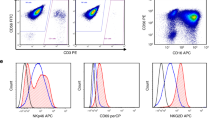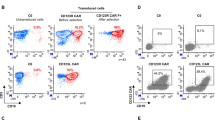Abstract
CD3+CD56−, CD4 and CD8 double negative T (DNT) cells comprise 1–3% of peripheral blood (PB) mononuclear cells. Their role in tumor immunity remains largely unknown due to their limited numbers and lack of effective methods to expand them. Here we developed a novel protocol by which DNT cells can be expanded ex vivo to therapeutic levels in 2 weeks from 13 of 16 acute myeloid leukemia (AML) patients during chemotherapy-induced complete remission. The expanded DNT cells expressed similar or higher levels of interferon-γ and tumor necrosis factor-α and Granzyme B as that seen in bulk activated CD8T cells from the same patient but significantly higher levels of perforin. The expanded DNT cells could effectively kill both allogeneic and autologous primary CD34+ leukemic blasts isolated from PB of AML patients in a perforin-dependant manner. These results demonstrate, for the first time, that DNT cells from AML patients can be expanded ex vivo even after intensive chemotherapy, and are effective at killing both allogeneic and autologous primary leukemic blasts. These findings warrant studies further exploring the potential of DNT cells as a novel adjuvant immunotherapy to decrease the risk of relapse in patients with AML and, perhaps, other cancers.
This is a preview of subscription content, access via your institution
Access options
Subscribe to this journal
Receive 12 print issues and online access
$259.00 per year
only $21.58 per issue
Buy this article
- Purchase on Springer Link
- Instant access to full article PDF
Prices may be subject to local taxes which are calculated during checkout




Similar content being viewed by others
References
Dohner H, Estey EH, Amadori S, Appelbaum FR, Buchner T, Burnett AK et al. Diagnosis and management of acute myeloid leukemia in adults: recommendations from an international expert panel, on behalf of the European LeukemiaNet. Blood 2010; 115: 453–474.
Litzow MR, Othus M, Cripe LD, Gore SD, Lazarus HM, Lee SJ et al. Failure of three novel regimens to improve outcome for patients with relapsed or refractory acute myeloid leukaemia: a report from the Eastern Cooperative Oncology Group. Br J Haematology 2010; 148: 217–225.
Litzow MR, Tarima S, Perez WS, Bolwell BJ, Cairo MS, Camitta BM et al. Allogeneic transplantation for therapy-related myelodysplastic syndrome and acute myeloid leukemia. Blood 2010; 115: 1850–1857.
Demirer T, Barkholt L, Blaise D, Pedrazzoli P, Aglietta M, Carella AM et al. Transplantation of allogeneic hematopoietic stem cells: an emerging treatment modality for solid tumors. Nat Clin Pract 2008; 5: 256–267.
Koreth J, Schlenk R, Kopecky KJ, Honda S, Sierra J, Djulbegovic BJ et al. Allogeneic stem cell transplantation for acute myeloid leukemia in first complete remission: systematic review and meta-analysis of prospective clinical trials. JAMA 2009; 301: 2349–2361.
Kolb HJ, Schattenberg A, Goldman JM, Hertenstein B, Jacobsen N, Arcese W et al. Graft-versus-leukemia effect of donor lymphocyte transfusions in marrow grafted patients. Blood 1995; 86: 2041–2050.
Collins Jr RH, Shpilberg O, Drobyski WR, Porter DL, Giralt S, Champlin R et al. Donor leukocyte infusions in 140 patients with relapsed malignancy after allogeneic bone marrow transplantation. J Clin Oncol 1997; 15: 433–444.
Levine JE, Braun T, Penza SL, Beatty P, Cornetta K, Martino R et al. Prospective trial of chemotherapy and donor leukocyte infusions for relapse of advanced myeloid malignancies after allogeneic stem-cell transplantation. J Clin Oncol 2002; 20: 405–412.
Schmidt-Wolf IG, Negrin RS, Kiem HP, Blume KG, Weissman IL . Use of a SCID mouse/human lymphoma model to evaluate cytokine-induced killer cells with potent antitumor cell activity. J Exp Med 1991; 174: 139–149.
Linn YC, Lau LC, Hui KM . Generation of cytokine-induced killer cells from leukaemic samples with in vitro cytotoxicity against autologous and allogeneic leukaemic blasts. Br J Haematol 2002; 116: 78–86.
Alvarnas JC, Linn YC, Hope EG, Negrin RS . Expansion of cytotoxic CD3+ CD56+ cells from peripheral blood progenitor cells of patients undergoing autologous hematopoietic cell transplantation. Biol Blood Marrow Transplant 2001; 7: 216–222.
Linn YC, Lau SK, Liu BH, Ng LH, Yong HX, Hui KM . Characterization of the recognition and functional heterogeneity exhibited by cytokine-induced killer cell subsets against acute myeloid leukaemia target cell. Immunology 2009; 126: 423–435.
Hoyle C, Bangs CD, Chang P, Kamel O, Mehta B, Negrin RS . Expansion of Philadelphia chromosome-negative CD3(+)CD56(+) cytotoxic cells from chronic myeloid leukemia patients: in vitro and in vivo efficacy in severe combined immunodeficiency disease mice. Blood 1998; 92: 3318–3327.
Young KJ, Kay LS, Phillips MJ, Zhang L . Antitumor activity mediated by double-negative T cells. Cancer Res 2003; 63: 8014–8021.
Young KJ, DuTemple B, Zhang Z, Levy G, Zhang L . CD4(-)CD8(-) regulatory T cells implicated in preventing graft-versus-host and promoting graft-versus-leukemia responses. Transplant Proc 2001; 33: 1762–1763.
Voelkl S, Moore TV, Rehli M, Nishimura MI, Mackensen A, Fischer K . Characterization of MHC class-I restricted TCRalphabeta+ CD4- CD8- double negative T cells recognizing the gp100 antigen from a melanoma patient after gp100 vaccination. Cancer Immunol Immunother 2009; 58: 709–718.
Kabelitz D, Wesch D, He W . Perspectives of gammadelta T cells in tumor immunology. Cancer res 2007; 67: 5–8.
Trus MR, Yang L, Suarez Saiz F, Bordeleau L, Jurisica I, Minden MD . The histone deacetylase inhibitor valproic acid alters sensitivity towards all trans retinoic acid in acute myeloblastic leukemia cells. Leukemia 2005; 19: 1161–1168.
Rayappa C, McCulloch EA . A cell culture model for the treatment of acute myeloblastic leukemia with fludarabine and cytosine arabinoside. Leukemia 1993; 7: 992–999.
Zhang ZX, Yang L, Young KJ, DuTemple B, Zhang L . Identification of a previously unknown antigen-specific regulatory T cell and its mechanism of suppression. Nat Med 2000; 6: 782–789.
Rosenberg SA, Restifo NP, Yang JC, Morgan RA, Dudley ME . Adoptive cell transfer: a clinical path to effective cancer immunotherapy. Nat Rev 2008; 8: 299–308.
Kataoka T, Shinohara N, Takayama H, Takaku K, Kondo S, Yonehara S et al. Concanamycin A, a powerful tool for characterization and estimation of contribution of perforin- and Fas-based lytic pathways in cell-mediated cytotoxicity. J Immunol 1996; 156: 3678–3686.
Aebersold P, Hyatt C, Johnson S, Hines K, Korcak L, Sanders M et al. Lysis of autologous melanoma cells by tumor-infiltrating lymphocytes: association with clinical response. J Natl Cancer Inst 1991; 83: 932–937.
Schwartzentruber DJ, Hom SS, Dadmarz R, White DE, Yannelli JR, Steinberg SM et al. In vitro predictors of therapeutic response in melanoma patients receiving tumor-infiltrating lymphocytes and interleukin-2. J Clin Oncol 1994; 12: 1475–1483.
June CH . Adoptive T cell therapy for cancer in the clinic. J Clin Investig 2007; 117: 1466–1476.
Dudley ME, Yang JC, Sherry R, Hughes MS, Royal R, Kammula U et al. Adoptive cell therapy for patients with metastatic melanoma: evaluation of intensive myeloablative chemoradiation preparative regimens. J Clin Oncol 2008; 26: 5233–5239.
Berg M, Lundqvist A, McCoy Jr P, Samsel L, Fan Y, Tawab A et al. Clinical-grade ex vivo-expanded human natural killer cells up-regulate activating receptors and death receptor ligands and have enhanced cytolytic activity against tumor cells. Cytotherapy 2009; 11: 341–355.
Rosenberg SA, Packard BS, Aebersold PM, Solomon D, Topalian SL, Toy ST et al. Use of tumor-infiltrating lymphocytes and interleukin-2 in the immunotherapy of patients with metastatic melanoma. A preliminary report. New Engl J Med 1988; 319: 1676–1680.
Gattinoni L, Klebanoff CA, Palmer DC, Wrzesinski C, Kerstann K, Yu Z et al. Acquisition of full effector function in vitro paradoxically impairs the in vivo antitumor efficacy of adoptively transferred CD8+ T cells. J Clin Investig 2005; 115: 1616–1626.
Muranski P, Boni A, Wrzesinski C, Citrin DE, Rosenberg SA, Childs R et al. Increased intensity lymphodepletion and adoptive immunotherapy--how far can we go? Nat Clin Pract 2006; 3: 668–681.
Wrzesinski C, Restifo NP . Less is more: lymphodepletion followed by hematopoietic stem cell transplant augments adoptive T-cell-based anti-tumor immunotherapy. Curr OpinImmunol 2005; 17: 195–201.
Antony PA, Piccirillo CA, Akpinarli A, Finkelstein SE, Speiss PJ, Surman DR et al. CD8+ T cell immunity against a tumor/self-antigen is augmented by CD4+ T helper cells and hindered by naturally occurring T regulatory cells. J Immunol 2005; 174: 2591–2601.
Gattinoni L, Finkelstein SE, Klebanoff CA, Antony PA, Palmer DC, Spiess PJ et al. Removal of homeostatic cytokine sinks by lymphodepletion enhances the efficacy of adoptively transferred tumor-specific CD8+ T cells. J Exp Med 2005; 202: 907–912.
Dummer W, Niethammer AG, Baccala R, Lawson BR, Wagner N, Reisfeld RA et al. T cell homeostatic proliferation elicits effective antitumor autoimmunity. J Clin Investig 2002; 110: 185–192.
Leemhuis T, Wells S, Scheffold C, Edinger M, Negrin RS . A phase I trial of autologous cytokine-induced killer cells for the treatment of relapsed Hodgkin disease and non-Hodgkin lymphoma. Biol Blood Marrow Transplant 2005; 11: 181–187.
Estey E, de Lima M, Tibes R, Pierce S, Kantarjian H, Champlin R et al. Prospective feasibility analysis of reduced-intensity conditioning (RIC) regimens for hematopoietic stem cell transplantation (HSCT) in elderly patients with acute myeloid leukemia (AML) and high-risk myelodysplastic syndrome (MDS). Blood 2007; 109: 1395–1400.
Gupta V, Chun K, Yi QL, Minden M, Schuh A, Wells R et al. Disease biology rather than age is the most important determinant of survival of patients > or = 60 years with acute myeloid leukemia treated with uniform intensive therapy. Cancer 2005; 103: 2082–2090.
Hunder NN, Wallen H, Cao J, Hendricks DW, Reilly JZ, Rodmyre R et al. Treatment of metastatic melanoma with autologous CD4+ T cells against NY-ESO-1. New Engl J Med 2008; 358: 2698–2703.
Lundqvist A, Yokoyama H, Smith A, Berg M, Childs R . Bortezomib treatment and regulatory T-cell depletion enhance the antitumor effects of adoptively infused NK cells. Blood 2009; 113: 6120–6127.
Lamb Jr LS, Lopez RD . gammadelta T cells: a new frontier for immunotherapy? Biol Blood Marrow Transplant 2005; 11: 161–168.
Acknowledgements
This study was funded by the Ontario Institute for Cancer Research through funding provided by the Government of Ontario and the Canadian Cancer Society (grant 020516) to LZ. LZ is a Maria H Bacardi Chair in Transplantation. We would like to thank Dr Andre Schuh for his insightful comments.
Author information
Authors and Affiliations
Corresponding author
Ethics declarations
Competing interests
The authors declare no conflict of interest.
Additional information
Supplementary Information accompanies the paper on the Leukemia website
Rights and permissions
About this article
Cite this article
Merims, S., Li, X., Joe, B. et al. Anti-leukemia effect of ex vivo expanded DNT cells from AML patients: a potential novel autologous T-cell adoptive immunotherapy. Leukemia 25, 1415–1422 (2011). https://doi.org/10.1038/leu.2011.99
Received:
Revised:
Accepted:
Published:
Issue Date:
DOI: https://doi.org/10.1038/leu.2011.99
Keywords
This article is cited by
-
Peripheral immune cell profiling of double-hit lymphoma by mass cytometry
BMC Cancer (2023)
-
CD4−/CD8− double-negative tumor-infiltrating lymphocytes expanded from solid tumor tissue suppress the proliferation of tumor cells in an MHC-independent way
Journal of Cancer Research and Clinical Oncology (2023)
-
Application of double-negative T cells in haematological malignancies: recent progress and future directions
Biomarker Research (2022)
-
Targeting late-stage non-small cell lung cancer with a combination of DNT cellular therapy and PD-1 checkpoint blockade
Journal of Experimental & Clinical Cancer Research (2019)
-
Human double negative T cells target lung cancer via ligand-dependent mechanisms that can be enhanced by IL-15
Journal for ImmunoTherapy of Cancer (2019)



